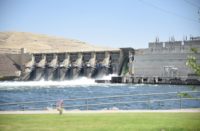A proposal to breach four dams in Washington state as part of a strategy to help local salmon populations recover would come “at significant cost and with a major infrastructure program” needed to replace services the dams support, according to a newly-released draft state report.
The draft report prepared by independent consultants for Gov. Jay Inslee (D) estimates the cost at between $10.3 billion and $27.2 billion. That would include breaching the dams’ earthen berms, possibly removing other structures, and a variety of transportation, energy and water infrastructure projects to replace those services.
The U.S. Army Corps of Engineers Walla Walla District owns and operates the four lower Snake River dams, which were built between the 1960s and 1970s and transformed the waterway from a free-flowing river to a series of reservoirs. The hydroelectric dams produce an average of 1 GW annually and up to 3.03 GW at peak capacity. They also allow more than 100 miles of river navigation between Lewiston, Idaho, and Tri-Cities, Wash., plus irrigation from the reservoirs they created, recreation and other services.
Officials have considered breaching the Snake River dams several times previously, but the idea has been controversial because of the economic impacts of services tied to the dams. The idea has repeatedly drawn interest as a way to bolster the declining populations of all four salmon species that use the river, all of which are classified as either threatened or endangered under the Endangered Species Act.
“Every community in the Pacific Northwest knows the value and importance of our iconic salmon runs—and every community recognizes the importance of salmon to our economy and cultural heritage," Gov. Inslee said in a statement. "We each remain firmly committed to saving our salmon. We also know that the dams provide significant benefits to our region’s economy and communities."
The dams were designed with fish ladders and other fish passage improvements have been added over time, but the draft report found that the dams have contributed to those declines. Breaching the dams is expected to have long-term benefits for salmon such as an improved juvenile migration survival rate.
Breaching the dams is estimated to cost between $1.24 billion and $2 billion, but replacing the dams’ benefits would cost much more. The largest anticipated costs are for energy. While the report notes the dams’ power generation could be replaced by a portfolio of renewable energy sources like solar and wind, that cost would range between $9.3 billion and $18.6 billion.
Commodity barging between Tri-Cities and Lewiston is lower cost for shipping goods than by rail or trucking, but would no longer be possible without the dams. That would require increased costs to upgrade and maintain shortline rail networks and both local and state roads. Those costs could run as high as $4.8 billion.
According to the Corps of Engineers, 40% of the U.S. wheat crop transits through the Snake River system. Deepening wells and undergoing other irrigation infrastructure work to replace water drawn from the dams’ reservoirs could cost another $1 billion. There would also be costs to compensate recreation industries impacted by the removals, and proposed costs for local economic development along the river.
Support and Opposition
The proposal has drawn support from environmental groups, the commercial and recreational fishing sectors and the NW Energy Coalition, a 100-member clean energy advocacy group.
“This draft report shows what we've known for years: we can replace the energy services of the lower Snake River dams and build a cleaner grid that improves reliability without sacrificing affordability,” Nancy Hirsh, coalition executive director, said in a statement. “The Northwest has planned for energy replacement of this scale before and we can do it again with smart planning, investments for a better future and regional collaboration.”
Others have questioned the impacts of the proposal. Heather Stebbings, executive director of the Pacific Northwest Waterways Association, a trade group of ports and other businesses related to river navigation, said in a statement that there “are significant gaps in the report as it relates to understanding the reality of shifting to alternative transportation modes, permitting and developing the infrastructure that would be required.”
“The report itself recognizes that more analysis needs to be done to fully assess the economic, social and transportation impacts associated with dam breaching,” Stebbings said. “It raises more questions than it answers and does not provide a solid foundation upon which a decision as substantial as this one could be made.”
Any move by the Corps of Engineers to breach the dams would already need congressional approval, but a group of lawmakers opposed to the proposal also said they would introduce a bill that would bar any “structural modification, action, study or engineering plan that restricts electrical generation” or limits navigation on the Snake River unless authorized by Congress. House lawmakers passed a similar bill in 2018, but the Senate never voted on it.
Rep. Dan Newhouse (R-Wash), who is sponsoring the bill, said breaching the dams “would be harmful to our communities, our environment and our economy.”
“The Snake River dams are integral to flood control, navigation, irrigation, agriculture and recreation in central Washington and our region cannot afford to lose them,” Newhouse said in a statement.
The draft report was released at the start of a public comment period that lasts through July 11. Comments can be submitted via an online form or by emailing info@lsrdoptions.org.
In a joint statement, Inslee and Sen. Patty Murray (D-Wash.), who released the report as part of a federal-state process to support salmon recovery, said they are approaching the breaching proposal “with open minds and without a predetermined decision.”
The final report is scheduled for release later this year and will inform the governor and senator's recommendations regarding the project.






Post a comment to this article
Report Abusive Comment